The Formation of Snow Crystals
By Ken Libbrecht
Subtle molecular processes govern the growth of a remarkable variety of elaborate ice structures
Subtle molecular processes govern the growth of a remarkable variety of elaborate ice structures

DOI: 10.1511/2007.63.52
Whether it is a tray of cubes in the freezer or the surface of a lake in winter, ice takes on the shape of its container. But when it comes to snowflakes, the same simple act of freezing water has a completely different result, producing a stunning diversity of complex patterned forms.
The variety of shapes is so remarkable that it easily supports the old adage that no two snowflakes are exactly alike. Even a casual look on a snowy day brings about the kind of wonder that prompted Henry David Thoreau to comment: "How full of the creative genius is the air in which these are generated! I should hardly admire more if real stars fell and lodged on my coat."

Photographs are courtesy of Kenneth G. Libbrecht and http://www.snowcrystals.com.
Water is such a common substance that one might expect that everything was already known about Thoreau's "creative genius"—how snowflakes develop into their complex structures. In fact, a great deal about the growth of these diminutive ice masterpieces remains maddeningly difficult to explain, even at the qualitative level. The growth of snowflakes is a highly nonlinear, nonequilibrium phenomenon, for which subtle processes at the nanoscale can profoundly affect the development of complex patterns at all scales. Understanding their formation requires a rich synthesis of molecular dynamics, surface physics, growth instabilities, pattern formation and statistical mechanics. Even though they fall from the winter clouds in vast numbers, we are only now on the verge of understanding why snowflakes form their distinctive shapes.
When water vapor in the atmosphere condenses directly into ice, bypassing the liquid phase, the resulting forms are properly called snow crystals. The word "snowflake" is a more general meteorological term, used to describe several different types of winter precipitation, anything from individual snow crystals to agglomerations of many crystals that collide and stick together, falling to earth as flimsy puffballs.
The formation of snow crystals usually begins when the wind causes a mass of warm, moist air to collide with a different mass of air, forming a weather front at their interface. If the collision pushes the warm air mass upward, then it cools as it rises. Once the air cools sufficiently, some of the water vapor it carries condenses into countless water droplets. Each droplet requires a nucleus on which to condense, and these are provided by particles of dust in the air. The micrometer-sized spheres are effective at scattering light, so vast numbers in aggregate form visible clouds. A good-sized cloud bank might contain a million or so tons of water, all in the form of suspended water droplets.
If the newly formed clouds continue to cool, dust plays another role in making snow. Water droplets do not freeze immediately when the temperature drops below zero degrees Celsius. Instead, they remain liquid in what is called a supercooled state. Pure water droplets can be supercooled to nearly -40 degrees before they freeze. Dust provides a solid surface to jump-start the freezing process, so dust-laden droplets begin to freeze at around -6 degrees. Since dust particles are all different, the cloud droplets do not all freeze at the same temperature. There is a gradual transition as a cloud cools and its droplets begin to freeze.
Once an individual droplet freezes, it begins to grow and develop as water vapor condenses onto its surface. Snow crystals are therefore made mostly from water vapor, not liquid water, solidifying directly into a crystal-lattice structure. The liquid droplets in the cloud that remain unfrozen slowly evaporate, supplying the air with the water vapor that creates their frozen brethren.
Thus there is a net transfer of water molecules from liquid droplets to water vapor to snow crystals. This is the round-about method by which the liquid water in a cloud freezes. Roughly one million cloud droplets must evaporate to provide sufficient water vapor for a single large snow crystal. The crystals become heavier as they grow, until gravity eventually pulls them out of their cloudy nurseries.
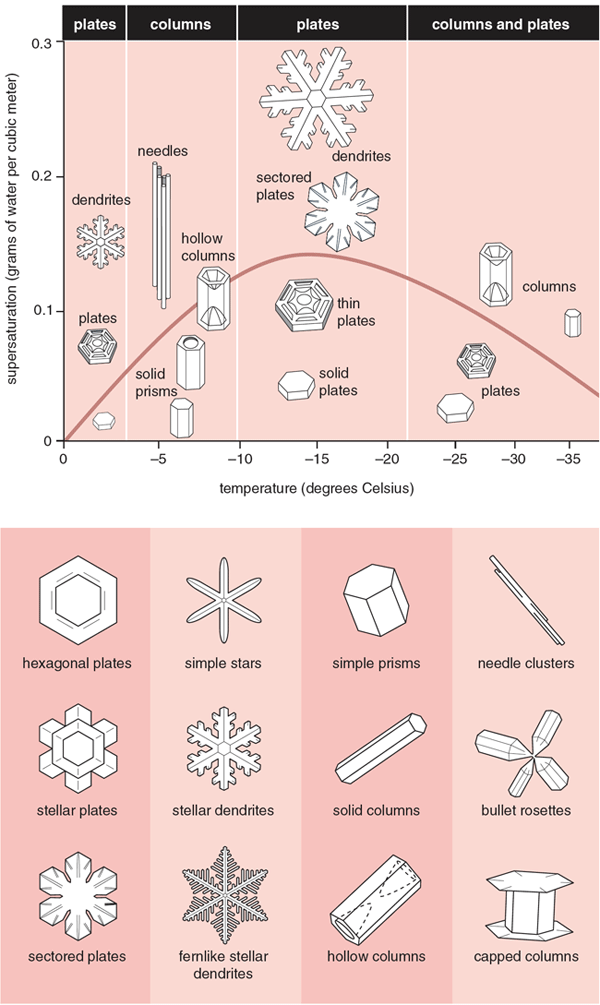
Barbara Aulicino
The angle between atoms in a water molecule mandates a hexagonally shaped ice lattice, which ultimately leads to the snowflake's sixfold symmetry. As a result, snow crystals first develop into small, faceted prisms, which may grow to a few tenths of a millimeter in size, about as large as the period at the end of this sentence. Depending on the details of how they grow, these simple crystals may become slender hexagonal columns shaped like wooden pencils, thin hexagonal plates, or anything in between.
The crystals typically develop more elaborate structures as they grow larger. Columnar snow crystals may become hollow columns, with conical voids in their ends, or they may grow into thin ice needles a few millimeters in length. Stout columns often form in clusters called bullet rosettes, so named because the individual columns have bullet-like shapes. There is competition for water vapor near the center of the collection, inhibiting growth in that area and giving each column a tapered look.
Small plates may sprout six primary branches, forming star-shaped, or stellar, snow crystals. A good-sized specimen might be 2 to 3 millimeters in diameter, about the size of this uppercase "O." The arms of broad-branched stellar plates are often decorated with ridges or other lavish patterns on their surfaces. The six primary branches of a stellar snow crystal might also sprout numerous additional side branches to form fernlike dendritic structures, measuring up to 10 millimeters in diameter. Side branches are always separated from one another by multiples of 60 degrees and run parallel to neighboring rows of branches.
Sometimes a snow crystal will begin growing as a column and then switch to plate growth, resulting in two platelike crystals on the ends of a connecting column, like wheels on an axle. These rare and somewhat exotic shapes are called capped columns.
It should be noted that fine examples of snowflake symmetry are more the exception than the rule. There are many mechanisms that can interrupt perfect snow crystal growth.
When a cloud droplet first freezes into a nascent snow crystal, it is just a few microns in size. As long as the droplet freezes into a single ice crystal without defects, its initial form is largely irrelevant in determining its final shape. The elaborate morphology of an individual snow crystal emerges with time as water vapor condenses on the crystal surface, causing the structure to develop. A snow crystal is not made by carving material away from a block of ice, but rather by selectively adding material. To understand the great variety of shapes and patterns in snow crystals, we must understand the dynamics of their growth.
The symmetry and complexity of snow crystals have been pondered for hundreds of years. German scientist Johannes Kepler, the first person to realize that planets orbit the Sun in elliptical paths, was also the first to examine snow crystals with a scientific eye. In 1611 Kepler penned a small treatise entitled The Six-Cornered Snowflake, in which he attempted to understand the flowerlike shapes of snow crystals. In comparing flowers and snowflakes, Kepler deduced:
Each single plant has a single animating principle of its own, since each instance of a plant exists separately, and there is no cause to wonder that each should be equipped with its own peculiar shape. But to imagine an individual soul for each and any starlet of snow is utterly absurd, and therefore the shapes of snowflakes are by no means to be deduced from the operation of soul in the same way as with plants.
If one replaces "soul" with "complex biochemistry of living organisms," Kepler was essentially correct in his thinking. There is no genetic blueprint that guides snow-crystal development. Their growth is determined by relatively simple physical rules—far simpler than the chemistry of living organisms—yet complex shapes emerge spontaneously. Kepler realized that the genesis of complex patterns and structures from simple precursors was a worthy scientific question, and it is one that scientists are still investigating today.
The advent of x-ray diffraction techniques in the 1920s illuminated crystalline structures, helping to lay the foundations of the field of crystallography, and soon revealed the sixfold symmetry of the ice-crystal lattice. The lattice structure helped to explain the sixfold symmetry of snow crystals, but by itself it does not explain the complex crystal morphologies.
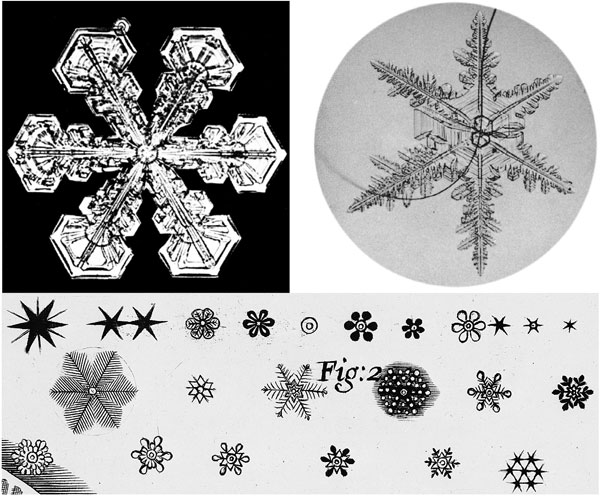
Top left photograph courtesy of the National Oceanic and Atmospheric Administration, top right reprinted by permission of Harvard University Press from Snow Crystals: Natural and Artificial by Ukichiro Nakaya.
Physicist Ukichiro Nakaya of the University of Hokkaido in Japan brought 20th-century scientific methods to bear on this problem in the 1930s in a remarkable series of observations and experimental investigations. After observing and documenting the range of natural snow-crystal types, Nakaya realized that laboratory experiments were necessary to investigate under what conditions the different crystal types appeared.
Nakaya developed several techniques for growing isolated snow crystals in test chambers and soon found that a crystal's morphology was mainly a function of the temperature and humidity of the air. Just below freezing, at around -2 degrees, thin platelike crystals appeared. Under slightly colder conditions, around -5 degrees, slender needles were the preferred shape. At -15 degrees, the largest and thinnest plate-like crystals formed, while below -25 degrees, the crystals grew mainly as short columns.
At all temperatures, Nakaya found that simple prismlike crystals formed when the humidity was low and growth was slow, whereas higher humidity yielded faster growth and more complex structures. Subsequent work has additionally shown that smaller crystals have generally simpler shapes, while larger crystals are more complex.
Nakaya displayed all his data in what is now called the snow-crystal morphology diagram, which displays the crystal shape as a function of temperature and humidity (see Figure 2). After 75 years, we still cannot explain many of the features seen in this simple diagram. In particular, the odd temperature dependence of the crystal morphology, exhibiting an almost oscillatory behavior between plates and columns over just a few degrees, is still largely an unsolved puzzle.
The morphology diagram can handily explain two immediately interesting features of snow crystals—why they all look so different and why the six branches on a stellar crystal all look alike. The explanation stems from Nakaya's observation that ice growth is remarkably sensitive to temperature and humidity.
As it blows about inside the clouds, a developing snow crystal experiences ever-changing temperatures and humidity levels during its travels. Each change in its local environment alters the way the crystal grows. Its growth may be platelike or columnar, faceted or branched, all depending on the conditions it sees. Because the sensitivity to temperature and humidity is so great, even modest variations inside a cloud cause large changes in growth behavior. After numerous twists and tumbles during its travels, the final structure of an individual crystal can be quite complex.
Furthermore, the route each growing snowflake takes is itself a highly random walk, influenced by the chaotic whorls and eddies that are ever present in the atmosphere. It is all but impossible for two snowflakes to follow exactly the same path though the clouds, so the likelihood of finding two identical snowflakes is basically nil. Luckily for snowflake watchers, nature has conspired to make a stunning variety of crystal forms.
Although each snowflake follows a different path, the arms of an individual stellar crystal travel together. The six arms all undergo the same changes in conditions at exactly the same times. As a result, the branches seem to grow in synchrony, simply because they each experience the same growth history. So Thoreau's "creative genius," capable of designing snow crystals in an endless variety of beautiful and symmetrical patterns, can simply be found in the ever-changing winds.
Going beyond the morphology diagram, much progress in understanding snow crystals has come from work in crystallography and metallurgy done by many scientists over several decades, as the foundations of modern materials science were being laid throughout the 20th century. The semiconductor industry provided considerable impetus in these fields, as suddenly the ability to produce large crystals—which required an understanding of their growth dynamics—was a business necessity.

Photographs courtesy of Kenneth G. Libbrecht and http://www.snowcrystals.com.
The formation of facets—flat crystalline surfaces—is a nearly ubiquitous phenomenon in crystal growth. Faceting plays a major role in guiding the growth of snow crystals. Once a cloud droplet freezes, the expanding crystal develops facets because some crystalline surfaces accumulate material more slowly than others. Condensing molecules are especially attracted to rounded surfaces that are rough on atomic scales, because such areas present greater available molecular binding. Molecularly flat regions—the facet surfaces—have fewer dangling chemical bonds and are thus less favorable attachment sites.
After a crystal grows for a while, only the slow-growing facet surfaces remain. The crystal eventually becomes faceted, regardless of its initial shape. The molecular bonding to the crystal lattice determines which surfaces grow slowly, and thus which lattice planes become facets. The process of faceting is how the geometry of the water molecule is transferred to the geometry of a large crystal.
Different mineral crystals have different facet structures, depending on the details of their molecular lattices. When faceting dominates snow crystal growth, the resulting hexagonal crystal has six side faces, called prism facets, capped by top and bottom surfaces, called basal facets. This is the basic shape of small or slow-growing snow crystals. Visible remnants of this form can often be seen at the centers of larger, more complex snow crystals, revealing their simpler initial shapes.
Under some conditions, water molecules will attach more readily to the prism surfaces than the basal surfaces, producing thin plates of ice. In other circumstances, the molecules attach to the basal facets, resulting in columns. In either case, faceting is one of the most important mechanisms for producing different shapes and patterns.
Faceting cannot be the whole story, however, or all snow crystals would be shaped like simple hexagonal prisms, which is certainly far from the case. Something else happens when the crystal size is large—typically about half a millimeter across—or when the growth is rapid. Then a crystal may sprout branches because of a well-known growth effect called the Mullins-Sekerka instability, or simply the branching instability. This process largely explains how complex, flowerlike snow-crystal structures can arise spontaneously from nothing more than freezing water vapor.
As snow crystals grow, they use up the water vapor in their immediate surroundings, and it takes a certain amount of time for additional molecules to diffuse through the air to reach the crystal. Snow-crystal growth is therefore said to be diffusion limited, and different regions on a crystal effectively compete for available resources. If a spot on a crystal—for example, one of the points on a hexagonal plate—sticks out farther into the air, then water molecules will preferentially collect on that point, simply because the diffusion distance is slightly shorter. With a slightly greater source of material, the point will grow a bit more rapidly, which in turn causes the point to become more pronounced. The result is a positive feedback that reinforces the effect, so large branches eventually sprout from the six points of a hexagonal snow crystal. With time, numerous side branches may in turn sprout from random bumps or faceted tips on the main arms.
Instabilities like this are at the heart of pattern formation, and nature is one unstable system heaped on top of another. The sun heats the air near the ground and the warm air rises—a convective instability that gives rise to the wind, clouds and the rest of Earth's weather. The resulting wind blows on the surface of the ocean, making the ocean surface unstable, which generates waves and drives moisture into the atmosphere. As these waves run into shallow beaches, they become unstable and break.
Faceting and branching are two dominant forces in snow-crystal growth, pulling in opposite directions. Faceting is a stabilizing process that drives the formation of flat surfaces and simple shapes. With faceting alone, snow crystals would all look like hexagonal prisms. In contrast, branching is an unstable process that takes simple shapes and makes them complex. Branching alone would produce crystals with much structure but no symmetry, looking a bit like miniature ice tumbleweeds. The constant interplay of both these forces is necessary to sculpt the shapes and patterns seen in snow crystals.
Although branching and faceting explain many properties of snow-crystal growth, they do not immediately explain the overall organization of the morphology diagram. For the past several decades, the assumption was that the growth rates of the prism and basal surfaces were simply temperature dependent. If the prism surfaces accumulated material more quickly than the basal surfaces, plates resulted. If the opposite occurred, columns and needles were formed. The relative growth rates would have to change dramatically with temperature—by at least two orders of magnitude over a few degrees—in order to be consistent with the morphology diagram, but no other explanation seemed possible.
For the past several years, I have been investigating snow-crystal formation by making precise measurements of crystal growth rates under well-controlled conditions. The idea is essentially the same as Nakaya's, except I can use the benefits of 21st-century technology: laser interferometry, digital data recording, exquisite temperature control and a host of other advances Nakaya could hardly have imagined.
I expected to see the growth vary strongly with temperature in my measurements, in order to agree with the morphology diagram. If thin plates and slender columns grew just a few degrees apart, then it stood to reason that the growth rates of the basal and prism facets would differ greatly from one another and change rapidly with temperature.
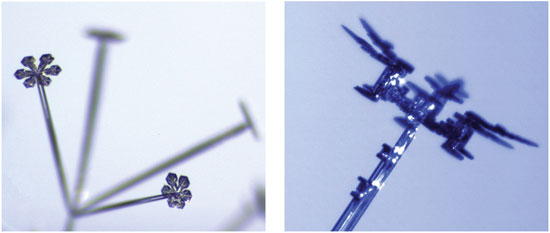
Photographs courtesy of Kenneth G. Libbrecht and http://www.snowcrystals.com.
My measurements showed otherwise. There were some differences among facets, but they were not nearly as great as expected. Likewise, the growth rates changed somewhat with temperature, but not nearly enough to explain the features seen in the morphology diagram.
The situation became even more intriguing when I began making careful computer models of the diffusion-limited growth of crystals, especially the growth of thin plates. The usual tenets of the branching instability suggested that the humidity should be highest at the edge of a plate, since this sticks out farthest into the air surrounding the crystal. Instead, my models indicated that the fast growth of the plate edges tends to deplete the water vapor there, so the humidity near the edge is actually lower than at other regions. This counterintuitive result meant that the branching instability could not promote the growth of thin plates and would actually drive the growth to blockier forms.
Putting the measurements and the modeling together made it impossible to explain the morphology diagram with what was known about ice-crystal growth. The modeling showed that growth rates had to change by a factor of 100 or even 1,000 over just a few degrees in temperature, which seemed implausible from what is known about crystal-growth dynamics. And indeed, the measurements showed that such rapid changes did not happen. Something new was needed to explain the dramatic changes in crystal shape with temperature.
I've become convinced that the solution lies in an effect I call structure-dependent attachment kinetics. The basic hypothesis is that the intrinsic growth rate of a faceted surface depends on its structure. In particular, I have proposed that an extremely narrow facet surface, as exists at the very edge of a thin, platelike crystal, will grow much faster than a broader facet. The molecular dynamics of how this happens are still unclear. One possibility stems from the fact that the molecules at the edge of a thin plate are more loosely bound than molecules on a broader surface, simply because they have fewer neighboring molecules to provide binding. This may cause the edge to become intrinsically rougher, as the surface molecules have more freedom to jostle about. A rougher surface is more accepting to condensing molecules, which could make the growth rates increase. The ice surface is known to have a rather complex molecular structure, which is not completely understood even in simpler circumstances, so it is not currently possible to prove or disprove this hypothesis. But I maintain that this phenomenon, or something quite similar, must exist to explain the data.
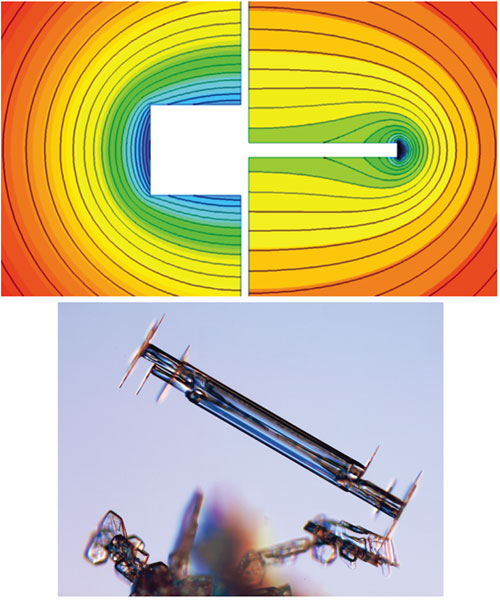
Photograph courtesy of Kenneth G. Libbrecht and http://www.snowcrystals.com.
The phenomenon of structure-dependent attachment kinetics leads to a new kind of growth behavior that I call the knife-edge instability. If the edge of a plate-like crystal, which starts out with some initial thickness, is made a bit thinner, then structure-dependent attachment kinetics dictates that the intrinsic growth rate of the edge will increase. The increased growth at the edge causes it to sharpen, which makes the edge still thinner, increasing the growth rate even more. Here again, there is a positive feedback that enhances the crystal growth and drives the formation of thin, platelike structures. The instability progresses until other mechanisms intercede to halt further sharpening of the edge.
Not only does the knife-edge instability reconcile the crystal-growth data in a reasonable way, it also explains many aspects of natural snow crystals. For example, Nakaya's early measurements showed that large stellar crystals have a characteristic thickness of about 0.01 millimeter (about a tenth of the thickness of a sheet of paper), which is largely independent of crystal size and the complexity of branching. Such behavior is just what one would expect from this type of instability, and it is hard to explain otherwise.
In addition, capped column crystals almost always show a sharp transition between the central column and the two plates on either end. This seemingly instantaneous growth change often produces crystals that have thin plates on the ends of a central column. One would expect a more gradual transition to be the norm, which would tend to produce thicker plates on columns, but this is not observed.
Explaining capped columns is rather easy with the knife-edge instability, because instabilities tend to amplify small changes in initial conditions. If the local environment changes just slightly to prefer platelike growth over columnar growth, then the instability kicks in to immediately produce thin plates. The instability amplifies the effects of slowly changing external conditions to produce an abrupt change in growth from columnar to platelike, as is usually seen.
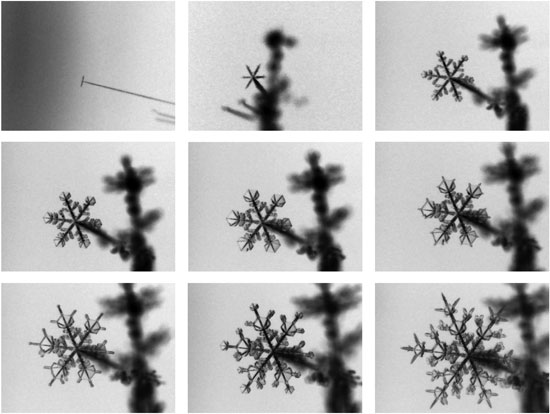
Photographs courtesy of Kenneth G. Libbrecht and http://www.snowcrystals.com.
This amplification is an important feature of the knife-edge instability, since it greatly reduces the intrinsic temperature-dependent growth changes that are needed to explain the morphology diagram. We still do not understand what those temperature-dependent effects are, but at least now they do not have to be so drastic. Small changes in growth with temperature can be amplified to produce the observed crystal morphologies.
The existence of the knife-edge instability suggests that the growth dynamics of nanoscale crystals can be quite different from those of larger structures. This phenomenon may be important for understanding the behavior of nanoscale devices in the semiconductor field, or any kind of nanoscale fabrication where it is desirable to self-assemble complex structures from bulk materials. At present, it not clear how ubiquitous this instability is or what other surprises one will find with nanoscale growth dynamics.
I believe that this newly discovered instability is a third major force in the formation of complex snow-crystal structures, as important as faceting and branching. It appears to be central in guiding the large-scale morphology of most snow crystals, and it provides an important amplification mechanism to explain the morphology diagram. Without the knife-edge instability, snow crystals would be smaller, thicker and blockier, lacking many of their most beautiful characteristics.
Although the knife-edge instability is a compelling idea, for now it remains a hypothesis. Additional measurements and theory are needed to understand this unusual crystal-growth phenomenon in detail. For example, we need a better understanding of the ice surface to explain the molecular dynamics responsible for structure-dependent attachment kinetics. At the molecular level, ice exhibits temperature-dependent surface melting, surface roughening and other complex phenomena. Molecular-dynamics models are making headway toward a deeper understanding of the surface physics of ice, but our knowledge is still far from complete. Ice continues to surprise us with its subtle surface properties, and understanding them at a molecular level is an ongoing challenge.

Images courtesy of David Griffeath and Janko Gravner.
Better ways to make computer models of crystal growth are also necessary. Considerable work has been done in modeling diffusion-limited solidification, and many aspects of pattern formation in such systems are well understood. To date, however, no one has been able to produce a physically accurate computer model of diffusion-limited growth in the presence of strong faceting. Some promising work in this area has recently been conducted by mathematicians David Griffeath of the University of Wisconsin-Madison and Janko Gravner of the University of California, San Diego, who are using cellular-automata models as a means to emulate diffusion-limited growth. In these models, basic growth rules are applied to the blocks on a grid iteratively over time to simulate the formation of a crystal. This relatively simple technique appears to avoid many of the computational problems inherent in direct numerical solutions of the diffusion equation, and their initial results reproduce many aspects of real snow-crystal growth, which has been a surprisingly elusive goal.
Additionally, it is key to make ever more precise measurements of crystal- growth rates under a broader sweep of external conditions. There is much yet to learn by creating crystals over a large spread of temperatures and humidities and in different background gases over a range of pressures. For instance, lowering pressure causes water molecules to diffuse more quickly, reducing branching in growing crystals. How pressure changes impact the knife-edge instability remains to be seen.
My group at Caltech is currently working on new techniques that use electrically modified ice-crystal growth to produce extremely slender needle crystals. We can then grow stationary platelike or columnar crystals on the tips of these needles under nearly any external conditions. Free from air currents, these crystals can grow larger than seen in nature, so far up to 25 millimeters. To a limited extent, we can even make designer snowflakes with patterns of our own choosing. Other groups, notably at the University of Washington and the Pennsylvania State University, are using electrodynamic levitation to grow isolated single crystals in different environments.
With better experimental data, novel computer modeling techniques and an ever-improving understanding of the molecular dynamics of the ice surface, we are now on the threshold of answering, in superb detail, the many questions put forth by Kepler some 400 years ago when he first pondered the shapes of snowflakes.
Click "American Scientist" to access home page
American Scientist Comments and Discussion
To discuss our articles or comment on them, please share them and tag American Scientist on social media platforms. Here are links to our profiles on Twitter, Facebook, and LinkedIn.
If we re-share your post, we will moderate comments/discussion following our comments policy.